Did you know that 85% of patients research orthodontists online before booking their first consultation?
More shocking: 60% of orthodontic practices lose high-value cases simply because patients can’t find them on Google.
The average orthodontic treatment costs $4,000-$8,000 per patient. Missing just five patients per month due to poor online visibility costs your practice $240,000+ annually in lost revenue.
In this guide, you’ll discover proven SEO strategies for orthodontists to rank higher for valuable treatment searches, attract qualified leads, and grow your practice revenue without expensive advertising.

Why SEO for Orthodontists Differs from General Dental Marketing
Orthodontic patients behave differently from emergency dental patients. They research extensively before making treatment decisions.
These patients spend weeks comparing orthodontists, reading reviews, and studying before/after photos.
Your orthodontic patients also have different search patterns that general dental SEO misses completely.
General Dental SEO | SEO for Orthodontists |
Emergency-focused searches | Research-driven searches |
Quick appointment needs | Extended decision process |
Insurance-dependent procedures | Investment-focused treatments |
Local geographic focus | Willing to travel for expertise |
Price-sensitive patients | Value-focused patients |
Orthodontic treatment works as a major investment. Parents want the best results for their children. Adult patients seek discreet treatment options that fit their lifestyle.
These patients will drive farther to find the right orthodontist. They also pay premium prices when they see exceptional results and service.
Target High-Value Orthodontic Keywords
Your SEO for orthodontists strategy must target keywords that show serious interest in treatment. These patients don’t search for “dentist near me” – they search for specific orthodontic solutions.
Just like effective SEO for startups requires niche keyword focus, orthodontic marketing needs treatment-specific targeting.
- Treatment-Specific Keywords
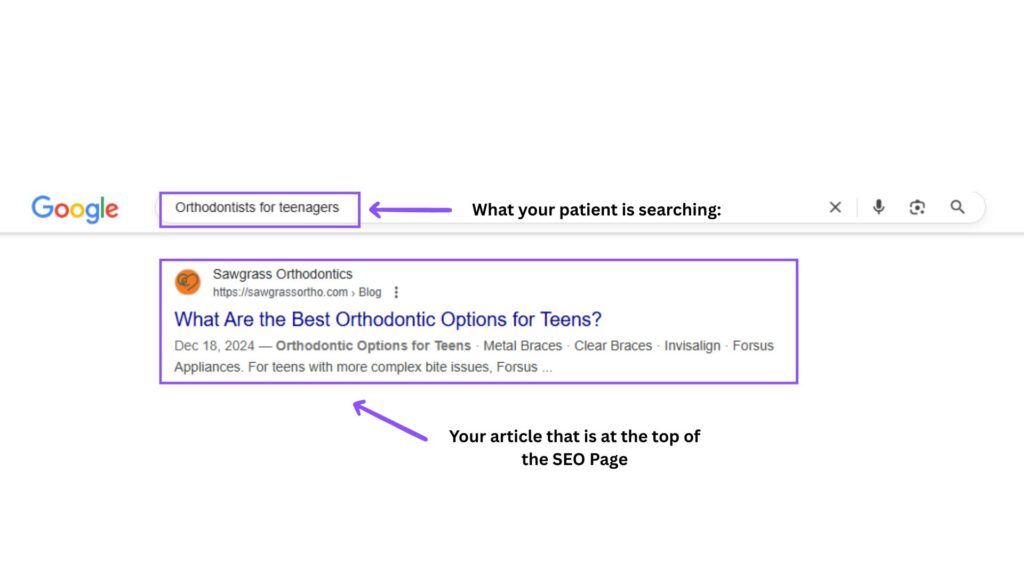
How SEO works for you as an orthodontist:
People who need orthodontic work search for exact treatments. They don’t just search for “orthodontist” – they search for the specific solution they want.
These searches bring you patients who are ready to invest money. They already know what treatment they need.
Keyword Type | Examples | Patient Intent |
Braces keywords | “metal braces cost”, “ceramic braces adults” | Price comparison |
| Invisalign searches | “Invisalign near me”, “clear aligners adults” | Treatment preference |
| Adult orthodontics | “adult braces options”, “orthodontist for adults” | Age-specific needs |
| Teen treatments | “teen braces”, “orthodontist for teenagers” | Parent research |
Your content should showcase your best treatment results. It should also answer the questions patients always ask about procedures.
- Local Orthodontist SEO Keywords
70% of patients who make location-based searches choose one of the top results. That’s the power of SEO.
Local search dominates orthodontic patient acquisition. Patients want convenient locations and prefer providers in their community.
An orthodontist near me’s SEO becomes critical for capturing local treatment searches. These keywords have lower competition than national terms.
Local Search Pattern (examples) | Monthly Volume | Competition Level |
“orthodontist near me” | High | Very High |
“orthodontist in Berlin” | Medium | High |
“Braces in Lincoln Park” | Medium | Medium |
“Invisalign 10001” | Low | Low |
Target your city, neighborhood, and surrounding areas. Include nearby schools and landmarks that parents recognize.
- Treatment Comparison Keywords
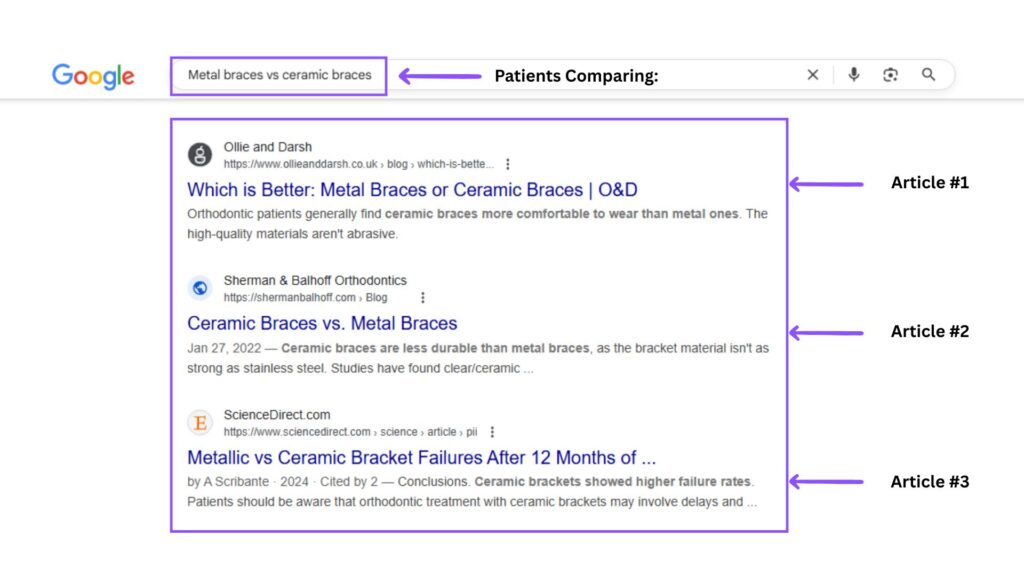
When patients click your article, it boosts your SEO and brings in more new patients to your practice.
Orthodontic patients compare multiple treatment options extensively. They want to understand the differences between brace types and treatment approaches.
Value-focused search patterns include:
- “Metal braces vs ceramic braces”
- “Invisalign vs traditional braces”
- “Orthodontic treatment options”
- “Best braces for adults”
Content addressing these comparisons builds trust. It also helps justify treatment recommendations during consultations.
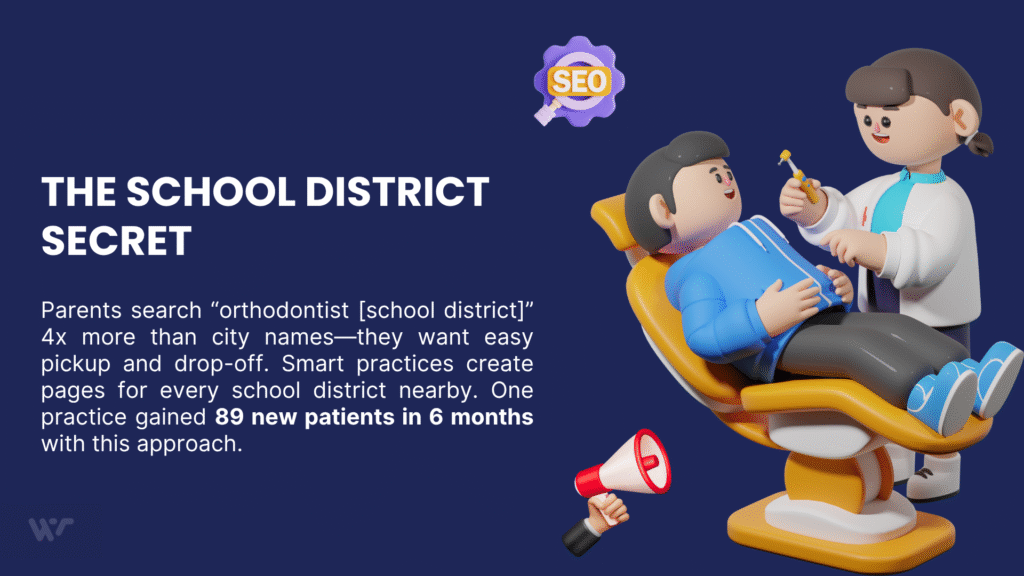
Step 1: Research Your Orthodontic Competition
Competitor analysis reveals which practices dominate local orthodontic searches. Study their content strategy to identify opportunities for your SEO for orthodontists approach.
Look for gaps in their treatment coverage. Find weak content that you can outperform with better patient resources.
- Analyze Their Treatment Content
Review which orthodontic treatments competitors target in their content. Missing or poorly covered treatments represent immediate opportunities.
Focus on high-value treatments where you have strong results and expertise to showcase.
Analysis Area | What to Look For | Opportunity Indicator |
Treatment pages | Comprehensive coverage | Missing procedures |
Before/after galleries | Quality and quantity | Poor visual content |
Patient testimonials | Authentic reviews | Generic testimonials |
Educational content | Treatment explanations | Confusing information |
- Study Their Local SEO Presence
Check how competitors perform for local SEO for orthodontist searches. Look at their Google My Business optimization and local directory listings.
Many orthodontic practices neglect local SEO basics. This creates opportunities for practices that are optimized properly.
- Examine Their Patient Education
Orthodontic patients need extensive education about treatment options, timelines, and expectations. Weak educational content from competitors creates opportunities.
Answer the questions patients ask most. Clear up false information they might have heard about orthodontic treatment.
Step 2: Create Treatment-Focused Content
SEO for orthodontists needs detailed treatment information and visual proof of results. Patients want to understand their options before scheduling consultations.
Pages with only basic information don’t work for orthodontic patients. They need comprehensive details about treatment processes and outcomes.
- Develop Treatment-Specific Landing Pages
Create dedicated pages for each major orthodontic service you offer. These pages should target specific treatments while showcasing your best results.
Each landing page needs high-quality before/after photos, detailed treatment explanations, and clear next steps for interested patients.
Landing Page Element | Purpose | Patient Benefit |
Before/after gallery | Show treatment results | Builds confidence in outcomes |
Treatment timeline | Explain duration expectations | Reduces anxiety about commitment |
Cost information | Address budget concerns | Makes treatment more accessible |
Patient testimonials | Provide social proof | Increases trust in practice |
Consultation booking | Enable easy action | Removes barriers to appointment |
- Create Educational Blog Content
Orthodontic blog posts help demonstrate your expertise. They also help you rank for more treatment-specific keywords.
Write about what patients actually want to know. Skip the technical jargon that confuses people.
Popular orthodontic blog topics include:
- Treatment comparison posts
- Age-specific orthodontic guides
- Cost and payment plan explanations
- Maintenance and care instructions
These posts should naturally connect to your main orthodontic services. They should also link to relevant treatment pages when appropriate.
Similar to effective SEO for dental practices strategies, orthodontic content must balance education with conversion optimization.
- Optimize Visual Content for Search
Image optimization becomes critical for SEO for orthodontists success. Search engines need to understand your visual content to rank it properly.
Use descriptive file names and alt text that include relevant orthodontic keywords. Before/after photos should include treatment names and location information.
Image Type | SEO Best Practice | Example Alt Text |
Before/after photos | Include treatment and location | “Teen braces before after Chicago orthodontist” |
Treatment process | Describe what’s shown | “Invisalign attachment placement procedure” |
Office photos | Include location and service | “Modern orthodontic office in Downtown Seattle” |
Staff photos | Include names and titles | “Dr. Smith orthodontist team photo” |
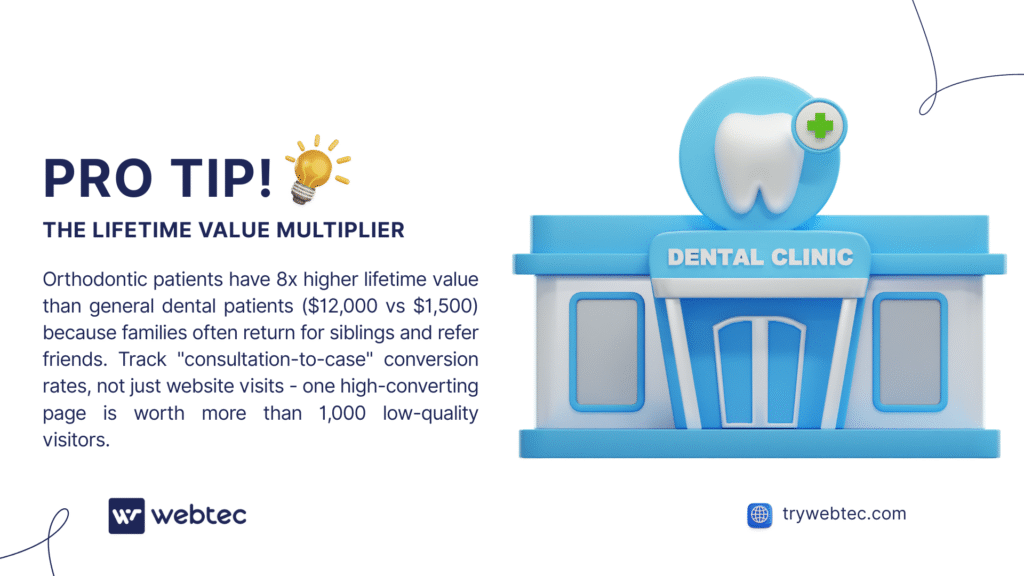
Step 3: Build Local Authority for Orthodontic Treatments
Local SEO for orthodontists requires different tactics than general dental practices. Your patients may travel farther but still search with local intent.
Build authority for orthodontic treatments in your geographic market through targeted local content and partnerships.
- Target Local Orthodontic Keywords
Combine orthodontic treatment terms with your location to capture local search traffic. These keywords have lower competition than generic orthodontic terms.
“Orthodontist SEO [city name]” strategies should focus on location-specific content that addresses local patient needs.
Local Keyword Strategy | Examples | Target Audience |
City + treatment | “Invisalign Chicago”, “braces Seattle” | City residents |
Neighborhood focus | “orthodontist Downtown”, “braces Westside” | Local communities |
School districts | “orthodontist [school district]” | Parents with children |
Landmarks | “braces near [mall/hospital]” | Convenience seekers |
- Partner with Local Healthcare Providers
Orthodontic treatment often requires coordination with general dentists and other specialists. These partnerships provide link opportunities and referral sources.
Consider cross-promotional content with local dentists who refer patients for orthodontic treatment.
Similar to local SEO for plumbers, orthodontic practices benefit from strong local business relationships and community connections.
- Sponsor Community Events
Get involved in local school events, health fairs, and community festivals. These activities help you meet families who need orthodontic care for their kids.
You also get valuable local website links from event organizers. This helps your Google rankings for local searches.
Event Type | SEO Benefit | Target Audience |
School health fairs | Local backlinks | Parents with children |
Community festivals | Brand visibility | Local families |
Sports team sponsorships | Local authority | Active families |
Dental society events | Professional credibility | Referring dentists |
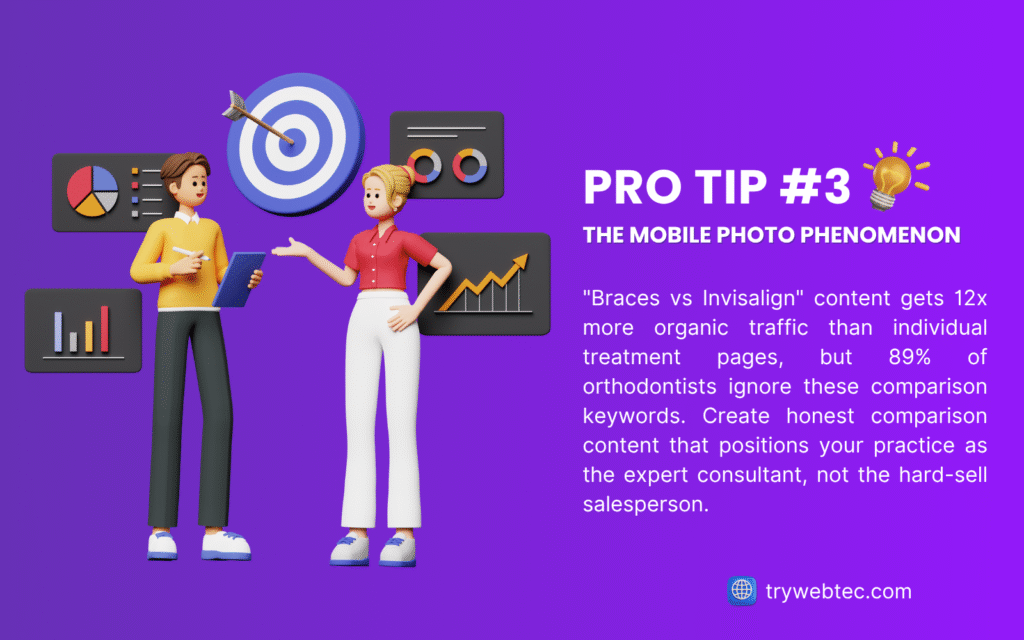
Step 4: Optimize for High-Converting Orthodontic Searches
SEO for orthodontists requires optimization for searches that indicate serious treatment interest rather than just information seeking.
Focus on keywords and content that attract patients ready to move forward with orthodontic treatment.
- Target Consultation-Intent Keywords
Searches that indicate readiness for consultation convert much higher than general information searches. Target these high-intent terms specifically.
Examples include:
- “orthodontist consultation”
- “braces consultation [city]”
- “Invisalign consultation near me”
- “orthodontic evaluation”
Content targeting these terms should make consultation booking as easy as possible with clear calls-to-action.
- Create Treatment Comparison Content
Orthodontic patients compare multiple treatment options before making decisions. Smart comparison content positions your practice favorably against alternatives.
Write honest comparisons that highlight your unique strengths without disparaging other treatment options directly.
Comparison Type | SEO Value | Content Focus |
Treatment options | High traffic | Braces vs aligners |
Age considerations | Medium traffic | Teen vs adult treatment |
Cost comparisons | High conversion | Payment plan options |
Timeline differences | Medium traffic | Treatment duration |
- Optimize for Mobile Orthodontic Searches
Many orthodontic searches happen on mobile devices as patients research treatment options during their commute or downtime.
Your visual content must load quickly and display properly on mobile devices to capture these potential patients.
Google Maps SEO for orthodontists becomes critical since many mobile searches include location intent.
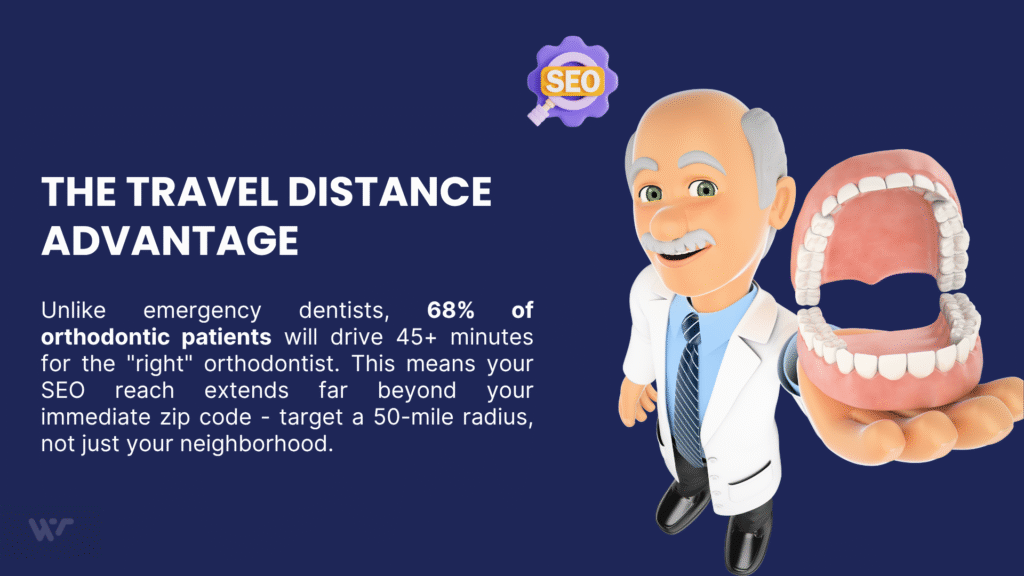
Step 5: Track Orthodontic SEO Performance
Measuring SEO for orthodontists requires different metrics than general dental practices. Focus on metrics that connect to high-value treatment consultations.
Track consultation requests and treatment-specific inquiries rather than just general appointment bookings.
- Key Orthodontic SEO Metrics
Check these numbers every month to see how your orthodontic SEO actually works:
Metric | What It Shows | Target Goal |
Organic traffic to treatment pages | Interest in specific treatments | 30%+ monthly growth |
Consultation requests from SEO | Quality lead generation | 60%+ of total consultations |
Treatment-specific form submissions | Treatment interest | 15%+ conversion rate |
High-value case starts | Revenue impact | 70%+ from organic search |
Local search rankings | Geographic visibility | Top 3 for target keywords |
- Calculate Treatment ROI
Track revenue from high-value orthodontic cases that originate from organic search. Compare this to your SEO investment to calculate return on investment.
Remember that orthodontic patients often refer family members and friends. One patient might lead to multiple treatment cases over time.
Orthodontic treatments generate significantly more revenue per patient than routine dental care. This makes it worthwhile to invest more in specialized SEO for orthodontists campaigns.
- Monitor Local Competition
Track how your local rankings compare to other orthodontic practices in your area. Look for opportunities to capture market share from competitors.
Local SEO for orthodontists requires consistent monitoring since new practices enter the market regularly.
Advanced SEO for Orthodontists Tactics
After you master the basics, you can implement more advanced SEO tactics for orthodontists. These methods require more investment but can help you outperform your competition.
You’ll need more time and resources for these tactics. But they usually deliver better results for orthodontic practices than basic SEO approaches.
- Develop Treatment Content Clusters
Organize orthodontic content into topic clusters around major treatment themes. This approach helps search engines understand your expertise areas.
Create pillar pages covering broad orthodontic topics with supporting pages that dive deeper into specific treatments and techniques.
Link related orthodontic content to distribute page authority and keep visitors engaged with your treatment expertise.
- Target Age-Specific Keywords
Orthodontic patients fall into distinct age groups with different needs and concerns. Create content that addresses age-specific orthodontic considerations.
Examples include:
- “orthodontics for children”
- “Teen braces options”
- “Adult orthodontic treatment”
- “Early orthodontic intervention”
Write content that speaks directly to each age group’s specific worries and goals.
- Optimize for Voice Search
More patients now ask Alexa or Siri about orthodontic treatments. They use normal conversation instead of typed keywords.
Focus on the questions people actually ask out loud. Think about how someone would talk to their phone or smart speaker.
Just like effective orthodontist clinic SEO services require adaptation to new technologies, voice search optimization helps capture emerging search behavior.
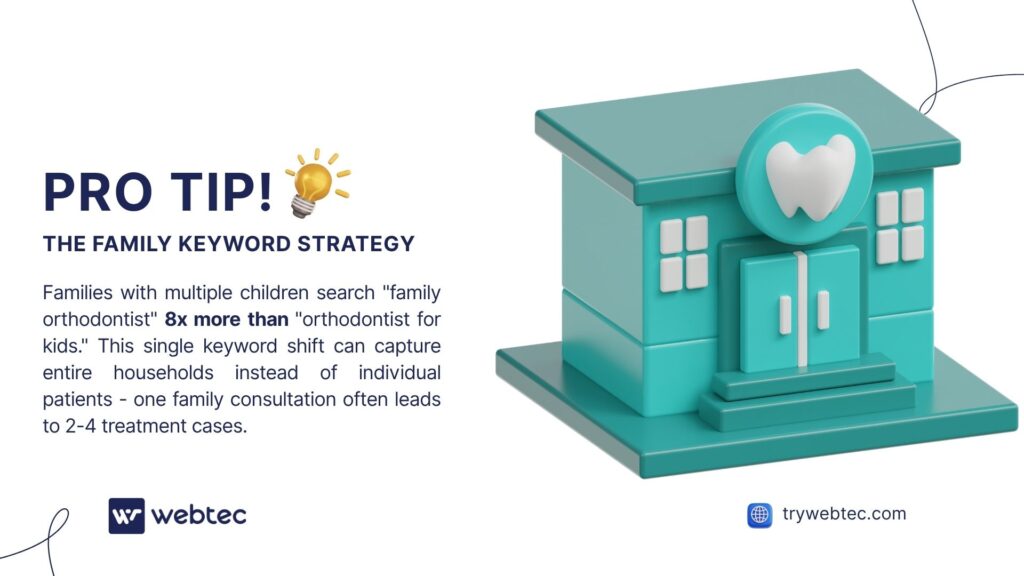
Common SEO Mistakes for Orthodontists
Most orthodontic practices make critical SEO mistakes that limit their ability to attract high-value treatment patients.
Avoid these common pitfalls to outperform competitors in local orthodontic searches.
- Don’t Focus Only on General Terms
Generic dental keywords rarely attract orthodontic patients who search for specific treatment options. Target treatment-specific terms instead.
Orthodontic patients use different language and search patterns than general dental care seekers who need basic dental SEO approaches.
- Avoid Poor Treatment Photography
Low-quality before/after photos hurt both SEO performance and patient conversion. Invest in professional photography that showcases your treatment expertise.
Search engines consider image quality and engagement metrics when ranking visual content.
- Don’t Ignore Patient Questions
Orthodontic treatment requires extensive patient education to build trust and justify investment. Provide detailed answers to common patient questions.
Educated patients make faster treatment decisions and become stronger advocates for your practice through positive reviews and referrals.
Common Mistake | Why It Fails | Better Approach |
Clinical terminology | Patients don’t search this way | Patient-friendly language |
Generic dental topics | Too much competition | Treatment-specific content |
No local focus | Misses local intent | Geographic targeting |
Poor mobile experience | Mobile searches fail | Mobile optimization |
Weak visual content | Orthodontics is visual | Professional photography |
Similar to effective SEO for cosmetic dentists strategies, orthodontic SEO requires specialized approaches that differ from general dental marketing.
Tools for SEO for Orthodontists’ Success
The right tools make SEO for orthodontists more efficient and effective. Focus on tools that help optimize treatment content and track procedure-specific performance.
Start with Google Analytics and Search Console to understand how patients find and interact with your orthodontic content.
- Local SEO Tools
Local SEO tools help track your performance for location-based orthodontic searches compared to other practices in your area.
These tools also help identify opportunities to improve your Google My Business optimization and local directory listings.
- Visual Content Management
Photography management systems help organize and optimize large galleries of treatment before/after photos.
Social media tools can amplify your visual content reach while driving traffic back to your optimized treatment pages.
- Competition Analysis Tools
SEO tools help identify which orthodontic keywords competitors target and which treatments drive their traffic.
Link analysis reveals opportunities to earn backlinks from healthcare and community websites that serve similar audiences.
The same approach that works for SEO for dentists applies here – use tools that provide actionable insights rather than just data.
- Analytics and Tracking
Set up proper tracking before you start major SEO efforts for orthodontists. You need baseline data to measure improvement accurately.
Custom dashboards help you monitor the metrics that matter most for patient acquisition. Focus on tracking data that connects to actual consultation bookings.
Regular reporting helps you identify trends and adjust strategies based on performance data. Monthly SEO reports help keep stakeholders informed about practice growth progress.
Tool Category | Purpose | Key Features |
Local SEO | Track local rankings | Geographic performance |
Analytics | Measure website performance | Traffic and conversion data |
Competition | Monitor competitors | Keyword and content analysis |
Visual | Optimize images | Photo compression and SEO |

Want More Qualified Patients, Higher Rankings, and No More Wasted Time on SEO That Doesn’t Work?
If you want to stop losing $8,000+ orthodontic cases to competitors, stop creating content that patients never find, and start attracting families who invest in premium treatment plans, then we can help you.
Webtec offers proven SEO services specifically designed for orthodontic practices that want to dominate local treatment searches.
Our data-driven approach has helped orthodontic practices increase their high-value treatment consultations by 200%+ through targeted organic search optimization.
So, if you’re ready to scale your orthodontic practice with qualified patients who actually book expensive treatments, discover how our specialized approach can transform your practice marketing results.



